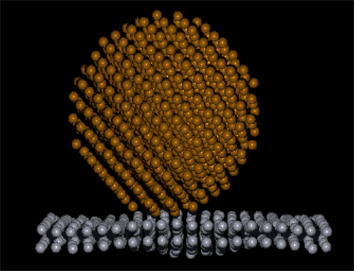IMD
 The molecular dynamics program IMD (ITAP Molecular Dynamics) is supporting several types of interactions, such as central pair potentials, EAM potentials for metals, Stillinger-Weber and Tersoff potentials for covalent systems, and Gay-Berne potentials for liquid crystals. Long-range interactions can be treated with Ewald- or Wolf-summation. variable dipoles are also supported.
The molecular dynamics program IMD (ITAP Molecular Dynamics) is supporting several types of interactions, such as central pair potentials, EAM potentials for metals, Stillinger-Weber and Tersoff potentials for covalent systems, and Gay-Berne potentials for liquid crystals. Long-range interactions can be treated with Ewald- or Wolf-summation. variable dipoles are also supported.
A rich choice of simulation options is available: different integrators for the simulation of the various thermodynamic ensembles, and a number of relaxators to optimize structures. In addition there are options that allow to deform the sample during the simulation to simulate epitaxy, shock waves or laser treatment, and many more.
IMD includes a number of utilities to evaluate the results and generate distributions, histograms, or for visualization. There is no restriction on the number of particle types.
The main design goals were to create a flexible and modular software reaching high performance on contemporary computer architectures, while being as portable as reasonably possible. IMD runs efficiently on both single processor workstations and massively parallel supercomputers, but is not very well suited for vector processors. The parallelization uses the standard MPI library for message passing together with OpenMP. As IMD is written in ANSI C, it is easily portable to any Unix-like environment.
IMD has won the SuParCup'97 and held the world record in molecular dynamics simulations in 1997 and 1999 with up to 5 billion particles. It is being used by many groups nationally and internationally.
Further information:
http://imd-doc.sourceforge.net/wiki/doku.php (Documentation)
https://github.com/itapmd/imd (Code)

